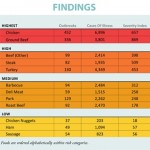
CSPI ranks meat and poultry according to risk
By Food in Canada magazine staff
Business Operations Food Safety Food TrendsA new report from a U.S. organization finds that Salmonella and E. coli O157:H7 are responsible for one-third of all foodborne illnesses
Washington, D.C. – A U.S. organization, which advocates for nutrition, health and food safety, has ranked categories of meat and poultry based on how sick they’ve made consumers.
The Center for Science in the Public Interest (CSPI) calls the report Risky Meat: A CSPI Field Guide to Meat & Poultry Safety.
The report came about after CSPI analyzed 12 years of documented foodborne illness outbreak data from the U.S. between 1998 and 2010. With that information, CSPI ranked meats and poultry according to how much risk they pose.
Risk rankings
The highest-risk category includes chicken and ground beef. The high-risk category includes beef (other), steak and turkey. The medium-risk category includes barbecue (beef or pork), deli meat, pork and roast beef. The low-risk category includes chicken nuggets, ham and sausage.
 CSPI says each food’s risk of causing severe illness was determined by calculating the hospitalization rate from the pathogen-specific illnesses attributed to outbreaks in the food groups.
CSPI says each food’s risk of causing severe illness was determined by calculating the hospitalization rate from the pathogen-specific illnesses attributed to outbreaks in the food groups.
Some food pathogen combinations may cause many illnesses, but those illnesses are less likely to result in hospitalization.
Conversely, some food-pathogen combinations may be rare, but cause more severe symptoms requiring hospital treatment.
CSPI says its researchers identified meat and poultry categories based on the food terms used most frequently by state outbreak investigators in their reports to the Centers for Disease Control and Prevention (CDC).
The meat and poultry products covered in the CSPI’s report were altogether responsible for 1,714 outbreaks, with more than 33,000 illnesses. Those illnesses ranged from short-term gastrointestinal distress to severe cases requiring hospitalization. Some resulted in death.
Incomplete picture
To ensure a high degree of confidence in the findings, only those illnesses linked to outbreaks that were definitively attributed to a meat or poultry product were used for this report’s analysis.
Ultimately, the 33,372 illnesses used in this analysis represent only a small fraction of likely cases; however, they do represent the best data available.
The picture painted from reported outbreak data is, unfortunately, incomplete. While the CDC estimates that 48 million Americans contract some form of foodborne illness each year, the vast majority of illnesses are not known and therefore not captured in outbreak data, either because they are “sporadic” (not linked to an outbreak) or because they are not diagnosed or reported to public health authorities.
The CSPI says it’s important to note that outbreaks linked to meat and poultry have decreased over the period from 1998 to 2010. Since 1993, the meat and poultry industry, spurred by stricter regulatory oversight and litigation, has made changes in animal production, slaughter, and processing to reduce illnesses from Salmonella, E. coli O157:H7, and other well-known hazards—but every outbreak of preventable illness and deaths shows that more work is needed.
Minimize risks
The aim of the report, says CSPI, is to help stakeholders throughout the food chain take steps to minimize the risks inherent in these foods:
• For consumers, knowing which of their favourite foods carry the greatest risks can help them take precautionary steps, such as safer handling and more thorough cooking.
• For producers and processors, information on which animal products are causing illness may provide crucial information for designing pre-harvest, slaughter, and processing systems that keep pathogens off meats and out of retail and consumer kitchens.
• For retailers and other foodservice providers, such as restaurants, cafeterias, and grocery stores, identifying storage and cooking practices that are linked to repeated outbreaks can help inform critically important food-handling practices.
CSPI found that Salmonella and E. coli O157:H7, two pathogens that contaminate meat and poultry during slaughter and processing, were together responsible for one-third of all illnesses.
Reducing these hazards should be the focus of the meat and poultry industry and regulators.
Clostridium perfringens, a little-publicized pathogen that grows on cooked foods left at improper temperatures for too long, was responsible for another one-third of illnesses linked to meat and poultry. That pathogen is commonly associated with food handling errors that occur after cooking, making it a key issue for the foodservice industry and consumers.
Finally, nearly 20 per cent of illnesses were from an unknown pathogen, due in part to incomplete data collection by public health departments. Increasing the percentage of outbreaks where pathogens and foods are identified is an issue that state health departments should address.
Photos from CSPI
Print this page